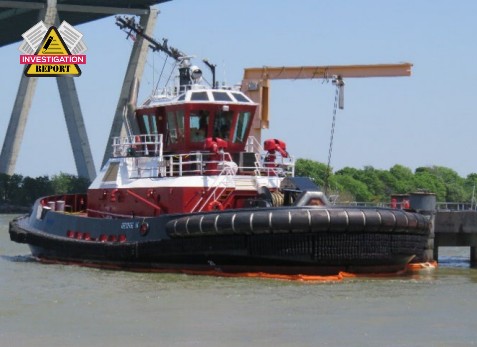The National Transportation Safety Board (NTSB) has issued an investigation report on the collision between tugboat George M and containership MSC Aquarius.
On April 14, 2022, about 0346 local time, the tugboat George M and containership MSC Aquarius collided while both vessels were transiting north in the Houston Ship Channel approaching Morgan’s Point, Texas. About 1,000 gallons of gear oil were released from the George M’s damaged port propulsion unit. No injuries were reported. Damage to the George M was estimated at $750,000; damage to the MSC Aquarius was $183,665.
To make up the George M to the MSC Aquarius at the center lead forward position, the mate maneuvered the tugboat, in darkness, into position centerline on the bow of the MSC Aquarius, which was transiting at 9.7 knots. The tugboat’s AB made up he heaving line to the hawser messenger, and the containership’s crew began heaving in the line. While this was occurring, the George M moved out of centerline with the MSC Aquarius. The mate attempted to maneuver the tugboat back to centerline, but he was unable to regain position, and his attempt to do so resulted in two collisions between the vessels.
Hydrodynamic forces created by a ship increase exponentially with speed, and therefore an increase of even a few knots will have a significant effect on the forces acting on a tugboat in the center lead position.7 The increased forces acting on a tugboat at higher speed require more reserve power, maneuverability, and operator skill to overcome.
When the George M approached the MSC Aquarius, the speed of the containership was 2.7 knots above the towing-company-directed limit of 7 knots for the bow-to-bow maneuver and 3.7 knots above the 6-knot limit preferred by pilots, tugboat captains, and ship masters surveyed by an International Tug Masters Association/Nautical Institute working group. Hydrodynamic forces also increase with decreasing distance to the bow, and, consequently, the forces acting on the George M were even greater as the tugboat approached the bow of the MSC Aquarius to make up the hawser.
In addition to producing significantly increased hydrodynamic forces, higher speed reduces the amount of reserve propulsion power available to the operator. If the tugboat moves out of position, the operator has less power to regain position as compared to the same maneuver at a lower ship’s transit speed. In this casualty, the difference between the maximum astern speed of the George M and the speed of the MSC Aquarius was 2.3 knots. In other words, the containership’s speed was 81% of the maximum astern speed of the tugboat, far greater than the 60% recommended in the Bow Tug Operations with Azimuth Stern Drive Tugs textbook. As an assisted ship’s speed increases, the margin of error decreases to the point where regaining position may be impossible.
Probable Cause
The National Transportation Safety Board determines that the probable cause of the collision between the tugboat George M and the containership MSC Aquarius was the George M mate’s attempt to make up bow to bow while the tugboat and containership were transiting at a speed that was excessive for the advanced harbor-assist maneuver. Contributing to the casualty was the George M mate’s lack of experience operating the tugboat.
Lessons Learned
Speed During Bow-to-bow Harbor-assist Operations
The risk of a casualty during bow-to-bow harbor-assist operations with azimuthing stern drive (ASD) tugboats increases with increasing speed. Hydrodynamic forces around an assisted vessel’s bow increase exponentially with speed, while the amount of reserve propulsion power available to the tugboat operator decreases. Therefore, owners and operators of ASD tugboats that perform bow-to-bow harbor-assist operations should set speed limits for these maneuvers. These limits may vary for different classes of tugboats based on design. Tugboat operators should communicate these pre-determined speed limits to ship masters or pilots in command of the vessels that they are assisting before engaging in these maneuvers.






























































